目录
1、Cookie-based认证的实现
2、Jwt Token 的认证与授权
3、Identity Authentication + EF 的认证
Cookie-based认证的实现
cookie认证方式如下图所示,当我们访问一个网页(Admin/Index)时候,这时候系统会检查你是否有权限,假如没有权限,便会我当前Url重定向到登陆页面(/Account/Login),在登陆成功后,系统会返回一个cookie保存在浏览器,此时再带着这个cookie去重新访问你最开始要访问的页面(Admin/Index)。如下图所示。
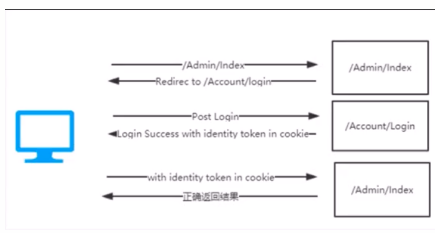
我们在.net core 中,也有一套基于cookie-basic的认证方式。
首先,创建一个Core 2.0的MVC项目,添加两个控制器AdminController代表我们要认证后才能访问的资源,AccountController,模拟登陆。在AccountController中,
1 [Authorize] 2 public class AdminController : Controller 3 { 4 public IActionResult Index() 5 { 6 return View(); 7 } 8 } 9 10 AdminController
1 public class AccountController : Controller 2 { 3 public async Task<IActionResult> MakeLogin() 4 { 5 var claims = new List<Claim> 6 { 7 new Claim(ClaimTypes.Name,"lmc"), 8 new Claim(ClaimTypes.Role, "admin") 9 }; 10 var claimsIdentity = new ClaimsIdentity( 11 claims, 12 CookieAuthenticationDefaults.AuthenticationScheme 13 ); 14 await HttpContext.SignInAsync(CookieAuthenticationDefaults.AuthenticationScheme, 15 new ClaimsPrincipal(claimsIdentity), 16 new AuthenticationProperties { 17 IsPersistent=true, //cookie过期时间设置为持久 18 ExpiresUtc= DateTime.UtcNow.AddSeconds(20) //设置过期20秒 19 }); 20 return Ok(); 21 } 22 public async Task<IActionResult> Logout() 23 { 24 await HttpContext.SignOutAsync( 25 CookieAuthenticationDefaults.AuthenticationScheme); 26 return Ok(); 27 } 28 } 29 30 AccountController
然后我们配置Startup,将认证服务加入到DI容器&&引用认证中间件。
public void ConfigureServices(IServiceCollection services)
{
services.AddAuthentication(CookieAuthenticationDefaults.AuthenticationScheme)
.AddCookie(config=>
{
config.LoginPath = "/Account/MakeLogin"; //未认证导向登陆的页面,默认为/Account/Login
config.Cookie.Name = "lmccookie"; //设置一个cookieName
});
services.AddMvc();
}
public void Configure(IApplicationBuilder app, IHostingEnvironment env)
{
if (env.IsDevelopment())
{
app.UseDeveloperExceptionPage();
app.UseBrowserLink();
}
else
{
app.UseExceptionHandler("/Home/Error");
}
app.UseStaticFiles();
app.UseAuthentication(); //加入认证中间件
...//// other code
}
测试下。 直接访问 Admin/Index被重定向到Login并返回我们定义的cookie,我们再带着cookie再次访问Admin/Index


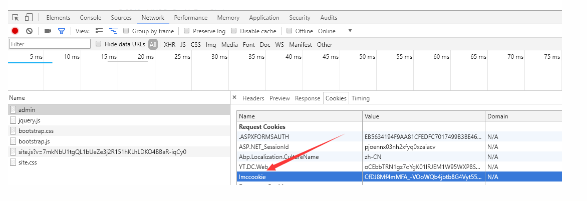
Jwt Token 的认证
JwtToken 一般用于一些前后端分离的项目或者是移动端的项目。大体流程是用户首先访问目标资源(例如这里的api/values),然后服务器返回一个401或者是403的响应码标识未授权登陆。这时用户应该重新登陆获取token (例如这里的api/token),拿到token以后,请求头里面带着token再去访问目标资源。
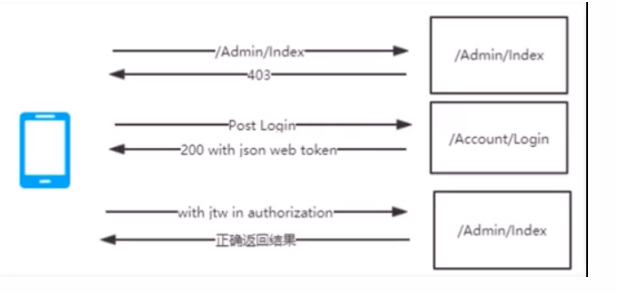
JwtToken 由三部分构成 首先是HEADER,这里面包含了Base64加密过的 加密算法和token的类型;PAYLOAD ,这里包含了一个Base64加密过的 Claims数组;SIGNATURE,包含了使用你的加密算法把加密过后的 HEADER ‘. ’ 和 PAYLOAD 加一个自定义的密钥。
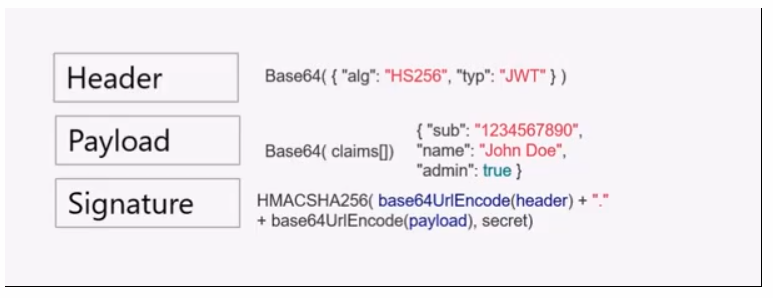
我们在.net core 中实现下Jwttoken的验证。
我们在ValuesController 打上[Authorize] 标签。配置我们的startup,在startup ConfigureServices方法中注入认证服务,Configure方法中添加中间件。 此时我们访问api/values=》返回401 的http状态码。
public void ConfigureServices(IServiceCollection services)
{
services.Configure<JwtSettings>(Configuration.GetSection("JwtSettings")); //appsettings中读取到jwtsettings节点
var jwtSetting = new JwtSettings();
Configuration.Bind("JwtSettings", jwtSetting);
services.AddAuthentication(options =>
{ // 添加认证头
options.DefaultAuthenticateScheme = JwtBearerDefaults.AuthenticationScheme;
options.DefaultChallengeScheme = JwtBearerDefaults.AuthenticationScheme;
})
.AddJwtBearer(jo => jo.TokenValidationParameters = new Microsoft.IdentityModel.Tokens.TokenValidationParameters()
{
ValidIssuer = jwtSetting.Issuer, //使用者
ValidAudience = jwtSetting.Audience, //颁发者
IssuerSigningKey = new SymmetricSecurityKey(Encoding.UTF8.GetBytes(jwtSetting.SecreKey)) //加密方式
});
services.AddMvc();
}
public void Configure(IApplicationBuilder app, IHostingEnvironment env)
{
if (env.IsDevelopment())
{
app.UseDeveloperExceptionPage();
}
app.UseAuthentication(); //注意加入中间件
Startup
public class JwtSettings
{
public string Issuer { get; set; } //办法token的人
public string Audience { get; set; } //token使用者
public string SecreKey { get; set; } //token加密钥
}
JwtSettings
{
"Logging": {
"IncludeScopes": false,
"Debug": {
"LogLevel": {
"Default": "Warning"
}
},
"Console": {
"LogLevel": {
"Default": "Warning"
}
}
},
"JwtSettings": {
"Audience": "http://localhost:5000",
"Issuer": "http://localhost:5000",
"SecreKey": "HelloKeylmclmclmc"
}
}
appsettings
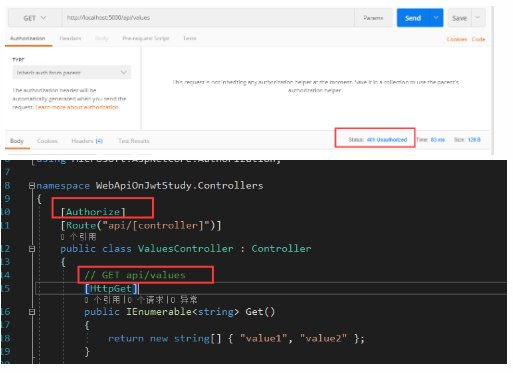
接下来需要生成token,添加一个AuthorizeController,通过构造函数把jwtsettings 注入进来,添加一个Index的Action 用来生成我们的token。我们需要一个验证下登录用户的用户名密码,所以还需要添加一个ViewModel
public class LoginViewModel
{
[Required]
public string Name { get; set; }
[Required]
public string PassWord { get; set; }
}
LoginViewModel
private JwtSettings _jwtSettings;
public AuthorizeController(IOptions<JwtSettings> options) //构造函数注入,拿到appsettings 里面的jwtsettings
{
_jwtSettings = options.Value;
}
[Route("api/token")]
[HttpPost]
public IActionResult Index(LoginViewModel loginViewModel)
{
if (!ModelState.IsValid)
return BadRequest();
if (!(loginViewModel.Name == "lmc" && loginViewModel.PassWord == "123456"))
return BadRequest();
var claims = new Claim[] //实例化一个Claim
{
new Claim(ClaimTypes.Name,"lmc"),
new Claim(ClaimTypes.Role, "admin")
};
var key = new SymmetricSecurityKey(Encoding.UTF8.GetBytes(_jwtSettings.SecreKey)); //将appsettings里面的SecreKey拿到
var creds = new SigningCredentials(key, SecurityAlgorithms.HmacSha256); //使用HmacSha256 算法加密
//生成token,设置过期时间为30分钟, 需要引用System.IdentityModel.Tokens.Jwt 包
var token = new JwtSecurityToken(_jwtSettings.Issuer, _jwtSettings.Audience, claims, DateTime.Now, DateTime.Now.AddMinutes(30), creds);
//将token返回
return Ok(new { token = new JwtSecurityTokenHandler().WriteToken(token) });
}
AuthorizeController
一切准备就绪,拿到Token。带着token来访问 /api/values,注意token需要带这常量 bearer 。
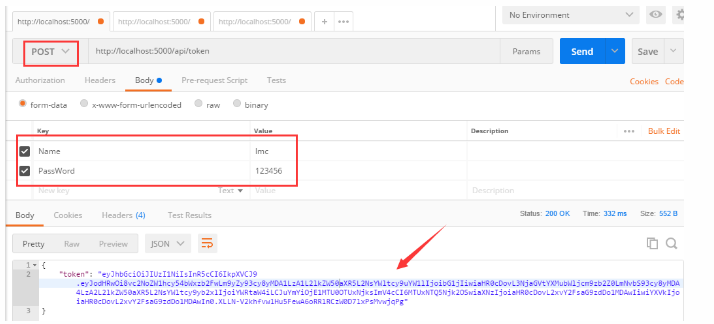
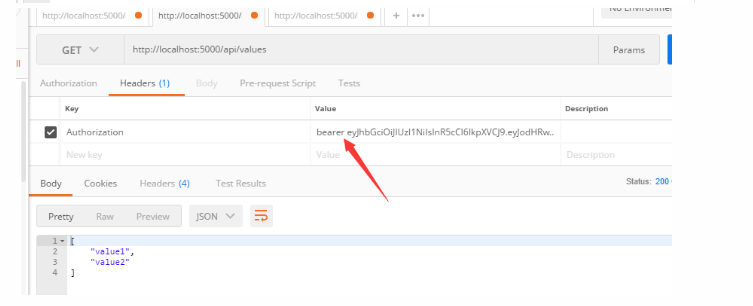
带着我们的加密钥来jwt官网验证一下。
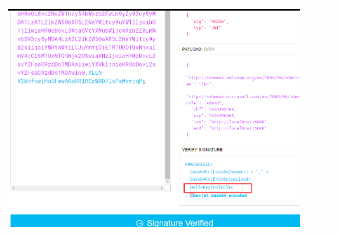
基于角色(Role),Claim/Policy 的授权:
在我们返回token的时候,实例化过一个Claim数组,其中,Role是admin。我们修改ValuesController的Authorize特性标签( [Authorize(Roles = "user")])。

当我们带着token再去验证时候。然后我们把Claim数组的Role那一项的Value 改为user 便会正常认证。

基于Claim的验证我们需要做的事在StartUp的ConfigureServices方法中,将授权模块加入到DI容器中。这里我们添加了一个SuperAdminOnlyd的Policy

此时,我们需要在AuthorizeController控制器返回Token的时候,需要在Claim数组中添加一个新的Claim,表示我们的Policy。

此时,再修改我们的ValuesController控制器的Authorize特性标签。

PostMan 走一波===》

Identity +EF Authentication 的认证
首先,使用net core 的脚手架命令创建一个自带Identity 的mvc项目。然后根据appseetings的数据库配初始化数据库(默认数据库实例是(localdb)\mssqllocaldb,因为我装vs时候没装这个,所以我换成了.) 。


还原完了数据库,就可以把项目跑起来了,可以根据右上角注册,登录下==》 (其中代码可以自行观看)
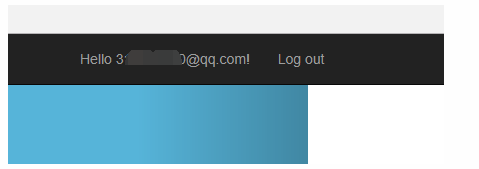
然后让我们来自己从头开始实现下这个过程:
可以在上文中Cookie认证的项目中完成,也可以新建一个空的MVC core项目。添加一个Account控制器,其中存在三个方法(action),注册、登录,登出。
using System;
using System.Collections.Generic;
using System.Linq;
using System.Threading.Tasks;
using Microsoft.AspNetCore.Mvc;
using System.Security.Claims;
using Microsoft.AspNetCore.Authentication.Cookies;
using Microsoft.AspNetCore.Authentication;
using MVCOnCookieBaseStudy.ViewModel;
using Microsoft.AspNetCore.Identity;
using MVCOnCookieBaseStudy.Models;
namespace MVCOnCookieBaseStudy.Controllers
{
public class AccountController : Controller
{
private UserManager<ApplicationUser> _userManager; //加入Identity自带的注册使用的Manager
private SignInManager<ApplicationUser> _signInManager; //加入Identity自带的登录使用的Manager
public AccountController(UserManager<ApplicationUser> userManager, SignInManager<ApplicationUser> signInManager)
{
_userManager = userManager;
_signInManager = signInManager;
}
/// <summary>
/// 注册页面
/// </summary>
/// <returns></returns>
public IActionResult Register(string returnUrl = "/Home/Index")
{
ViewData["ReturnUrl"] = returnUrl;
return View();
}
[HttpPost]
public async Task<IActionResult> Register(RegisterViewModel registerViewModel, string returnUrl = "/Home/Index")
{
ViewData["ReturnUrl"] = returnUrl;
if (ModelState.IsValid) //model 验证
{
ApplicationUser identityUser = new ApplicationUser
{
Email = registerViewModel.Email,
UserName = registerViewModel.Email,
NormalizedUserName = registerViewModel.Email
};
var result = await _userManager.CreateAsync(identityUser, registerViewModel.Password);
if (result.Succeeded)
{
await _signInManager.SignInAsync(identityUser, new AuthenticationProperties { IsPersistent = true });
return Redirect(returnUrl);
}
else
{
foreach(var err in result.Errors)
{
ModelState.AddModelError("", err.Description);
}
}
}
return View();
}
/// <summary>
/// 登录页面
/// </summary>
/// <returns></returns>
public IActionResult Login(string returnUrl = "/Home/Index")
{
ViewData["ReturnUrl"] = returnUrl;
return View();
}
[HttpPost]
public async Task<IActionResult> Login(RegisterViewModel LoginViewModel, string returnUrl = "/Home/Index")
{
ViewData["ReturnUrl"] = returnUrl;
var loginUser = await _userManager.FindByEmailAsync(LoginViewModel.Email);
if (loginUser == null)
{
return View();
}
await _signInManager.SignInAsync(loginUser, new AuthenticationProperties { IsPersistent = true });
return Redirect(returnUrl);
}
/// <summary>
/// 原来的Cookie登录
/// </summary>
/// <returns></returns>
public async Task<IActionResult> MakeLogin()
{
var claims = new List<Claim>
{
new Claim(ClaimTypes.Name,"lmc"),
new Claim(ClaimTypes.Role, "admin")
};
var claimsIdentity = new ClaimsIdentity(
claims,
CookieAuthenticationDefaults.AuthenticationScheme
);
await HttpContext.SignInAsync(CookieAuthenticationDefaults.AuthenticationScheme,
new ClaimsPrincipal(claimsIdentity),
new AuthenticationProperties {
IsPersistent=true, //cookie过期时间设置为持久
ExpiresUtc= DateTime.UtcNow.AddSeconds(20) //设置过期20秒
});
return Ok();
}
/// <summary>
/// 登出
/// </summary>
/// <returns></returns>
public async Task<IActionResult> Logout()
{
await _signInManager.SignOutAsync();
return Redirect("/Home/Index");
}
}
//覆盖默认验证
public class MyCookieTestAuthorize: CookieAuthenticationEvents
{
public override Task ValidatePrincipal(CookieValidatePrincipalContext context)
{
return base.ValidatePrincipal(context);
}
}
}
AccountController
@using MVCOnCookieBaseStudy.ViewModel
@model RegisterViewModel
@{
ViewData["Title"] = "Register";
}
<h2>@ViewData["Title"]</h2>
<div class="row">
<div class="col-md-4">
<form asp-route-returnUrl="@ViewData["ReturnUrl"]" method="post">
<h4>Create a new account.</h4>
<hr />
<div asp-validation-summary="All" class="text-danger"></div>
<div class="form-group">
<label asp-for="Email"></label>
<input asp-for="Email" class="form-control" />
<span asp-validation-for="Email" class="text-danger"></span>
</div>
<div class="form-group">
<label asp-for="Password"></label>
<input asp-for="Password" class="form-control" />
<span asp-validation-for="Password" class="text-danger"></span>
</div>
<div class="form-group">
<label asp-for="ConfirmPassword"></label>
<input asp-for="ConfirmPassword" class="form-control" />
<span asp-validation-for="ConfirmPassword" class="text-danger"></span>
</div>
<button type="submit" class="btn btn-default">Register</button>
</form>
</div>
</div>
@section Scripts {
@await Html.PartialAsync("_ValidationScriptsPartial")
}
注册的View
@using MVCOnCookieBaseStudy.ViewModel
@model RegisterViewModel
@{
ViewData["Title"] = "Login";
}
<h2>Login</h2>
<div class="row">
<div class="col-md-4">
<section>
<form asp-route-returnurl="@ViewData["ReturnUrl"]" method="post">
<h4>Use a local account to log in.</h4>
<hr />
<div asp-validation-summary="All" class="text-danger"></div>
<div class="form-group">
<label asp-for="Email"></label>
<input asp-for="Email" class="form-control" />
<span asp-validation-for="Email" class="text-danger"></span>
</div>
<div class="form-group">
<label asp-for="Password"></label>
<input asp-for="Password" class="form-control" />
<span asp-validation-for="Password" class="text-danger"></span>
</div>
<div class="form-group">
<button type="submit" class="btn btn-default">Log in</button>
</div>
</form>
</section>
</div>
</div>
@section Scripts{
@await Html.PartialAsync("_ValidationScriptsPartial"); @*前端验证,需要引用jquery.validate.min.js*@
}
登录的View
这个过程中需要使用到一个ViewModel,用来传递登录数据
using System;
using System.Collections.Generic;
using System.ComponentModel.DataAnnotations;
using System.Linq;
using System.Threading.Tasks;
namespace MVCOnCookieBaseStudy.ViewModel
{
public class RegisterViewModel
{
[Required]
[EmailAddress]
[Display(Name = "Email")]
public string Email { get; set; }
[Required]
[DataType(DataType.Password)]
[StringLength(100, ErrorMessage = "The {0} must be at least {2} and at max {1} characters long.", MinimumLength = 6)]
[Display(Name = "Password")]
public string Password { get; set; }
[DataType(DataType.Password)]
[Display(Name = "Confirm password")]
[Compare("Password", ErrorMessage = "The password and confirmation password do not match.")]
public string ConfirmPassword { get; set; }
}
}
RegisterViewModel
添加集成自Identity的User 和 Role还有数据库链接上下文
public class ApplicationUserRole: IdentityRole
{
}
public class ApplicationUser:IdentityUser
{
}
Role&&User
public class ApplicationDbContext:IdentityDbContext<ApplicationUser,ApplicationUserRole,string>
{
public ApplicationDbContext(DbContextOptions<ApplicationDbContext> options) : base(options)
{
}
}
数据库链接上下文
接下来配置我们的StartUp,在ConfigureServices方法中 将数据库连接上下文加入DI容器,Identity服务加入DI容器,重新配置下我们的密码规则。(注意在Configure加入认证中间件)
public void ConfigureServices(IServiceCollection services)
{
//连接数据库服务加入DI容器
services.AddDbContext<ApplicationDbContext>(option =>
{
option.UseSqlServer(Configuration.GetConnectionString("DefaultConnection"));
});
//将Identity服务加入DI容器
services.AddIdentity<ApplicationUser, ApplicationUserRole>()
.AddEntityFrameworkStores<ApplicationDbContext>()
.AddDefaultTokenProviders();
//设置注册密码的规则
services.Configure<IdentityOptions>(options =>
{
options.Password.RequireLowercase = false;
options.Password.RequireNonAlphanumeric = false;
options.Password.RequireUppercase = false;
});
services.AddAuthentication(CookieAuthenticationDefaults.AuthenticationScheme)
.AddCookie(config=>
{
config.LoginPath = "/Account/Login"; //未认证导向登陆的页面,默认为/Account/Login
config.Cookie.Name = "lmccookie"; //设置一个cookieName
});
services.AddMvc();
}
Startup ConfigServices
